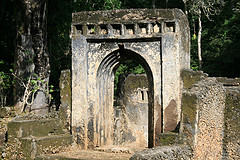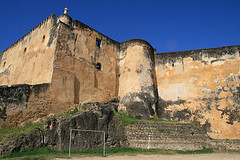Zanzibar: Spices and Spiky Monkeys
Tuesday, July 27th, 2010“This Zanzibar better be worth it,” grumbled Wendy as she forked over US$100 for her Tanzania visa (almost all other nationalities pay $50), the seventh time she has had to pay at least $100 for a tourist visa during our travels. Luckily, despite warily eyeing Zanzibar through Lamu-coloured glasses upon arrival, we were soon happy to be there and it was well worth it.
 The major difference between Lamu and Zanzibar is scale – the latter is grander in all facets, from the size of the Stone Town to the size of the houses within it to the width of the alleyways (and, yes, the number of tourists). Zanzibar has more historic non-residential buildings and you can tell that in the heyday of the Swahili Coast, Zanzibar yielded real power while Lamu was always somewhat of a backwater. Some other points in Zanzibar’s favour are sunsets, town beaches – good for watching locals play football and haul in fishing boats – and a wider variety of food. Lamu counters with better fruit juice, a more personal touch (after a couple of days it seems like everyone knows you) and the feeling that you’ve stumbled on a less well-trodden path.
The major difference between Lamu and Zanzibar is scale – the latter is grander in all facets, from the size of the Stone Town to the size of the houses within it to the width of the alleyways (and, yes, the number of tourists). Zanzibar has more historic non-residential buildings and you can tell that in the heyday of the Swahili Coast, Zanzibar yielded real power while Lamu was always somewhat of a backwater. Some other points in Zanzibar’s favour are sunsets, town beaches – good for watching locals play football and haul in fishing boats – and a wider variety of food. Lamu counters with better fruit juice, a more personal touch (after a couple of days it seems like everyone knows you) and the feeling that you’ve stumbled on a less well-trodden path.
 We spent most of our time in Zanzibar walking around Stone Town, visiting the local markets, and eating seafood pizza at Mercury’s overlooking the beach. Other than this, yesterday we did the virtually obligatory spice/beach tour, which we found OK but not outstanding. A better outing this morning was taking a dalla-dalla (the local converted truck transport) to a beautiful forest to see red colobus monkeys, the spiky-haired version of which lives only on Zanzibar.
We spent most of our time in Zanzibar walking around Stone Town, visiting the local markets, and eating seafood pizza at Mercury’s overlooking the beach. Other than this, yesterday we did the virtually obligatory spice/beach tour, which we found OK but not outstanding. A better outing this morning was taking a dalla-dalla (the local converted truck transport) to a beautiful forest to see red colobus monkeys, the spiky-haired version of which lives only on Zanzibar.
As for Tanzania … that’s it. We were as surprised as anyone to discover, when we started our research, that Tanzania would not be the fulcrum of the trip as we had anticipated and instead would be a virtual obstacle in our path. The thing is, Tanzania and Kenya have very similar attractions, and if you’ve travelled significantly in one of them, there’s not much point in spending a lot of time in the other on the same trip. All four of Tanzania’s main attractions have a (cheaper) Kenyan ‘equivalent’: Mt. Kiliminjaro = Mt. Kenya, Serengeti NP / Ngorongoro Crater = Masai Mara NR, Zanzibar = Lamu.
So, after considering flying to the Rwandan capital Kigali but baulking at the $900 price, we will take the ferry to Dar es Salaam tomorrow and then face an overland journey across Tanzania to Kigali that, if we’re lucky and get good connections, will take us two days.
Insha’allah.



